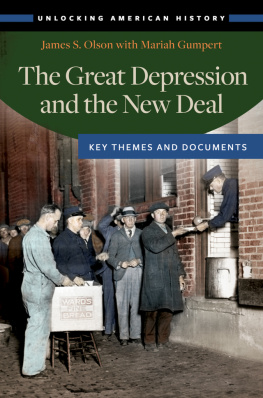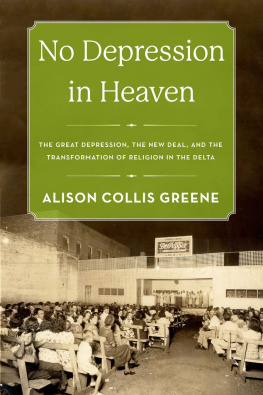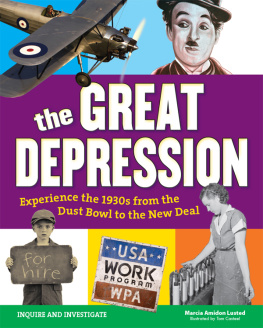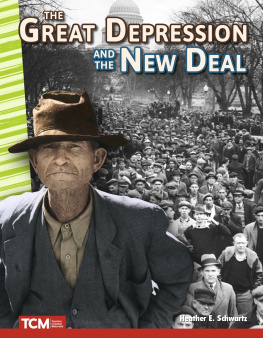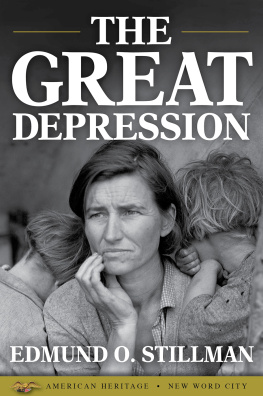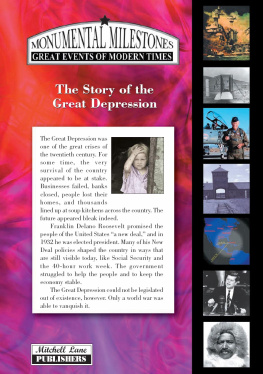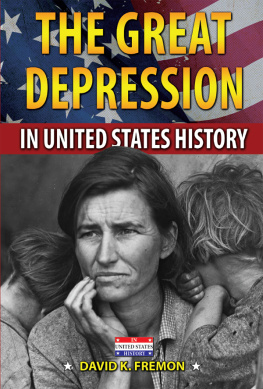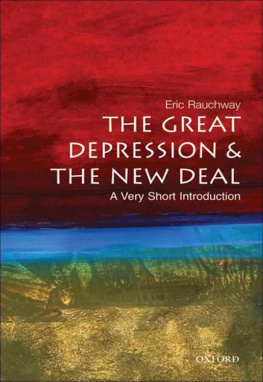The Great Depression and the New Deal
Recent Titles in the Unlocking American History Series
The Industrial Revolution: Key Themes and Documents
James S. Olson with Shannon L. Kenny
THE GREAT DEPRESSION AND THE NEW DEAL
Key Themes and Documents
James S. Olson with Mariah Gumpert
Unlocking American History
Copyright 2017 by ABC-CLIO, LLC
All rights reserved. No part of this publication may be reproduced, stored in a retrieval system, or transmitted, in any form or by any means, electronic, mechanical, photocopying, recording, or otherwise, except for the inclusion of brief quotations in a review, without prior permission in writing from the publisher.
Library of Congress Cataloging-in-Publication Data
Names: Olson, James Stuart, 1946author. | Gumpert, Mariah, author.
Title: The Great Depression and the New Deal : key themes and documents / James S. Olson with Mariah Gumpert.
Description: Santa Barbara : ABC-CLIO, 2017. | Series: Unlocking American history | Includes bibliographical references and index.
Identifiers: LCCN 2017007596 (print) | LCCN 2017021568 (ebook) | ISBN 9781440834639 (ebook) | ISBN 9781440834622 (hardback)
Subjects: LCSH: Depressions1929United States. | New Deal, 19331939. | United StatesEconomic conditions19181945. | United StatesSocial conditions19331945. | United StatesPolitics and government19291933. | United StatesPolitics and government19331945. | BISAC: HISTORY / United States / 20th Century. | HISTORY / Modern / 20th Century. | HISTORY / Reference.
Classification: LCC HB3717 1929 (ebook) | LCC HB3717 1929 .O47 2017 (print) | DDC 330.973/0917dc23
LC record available at https://lccn.loc.gov/2017007596
ISBN: 978-1-4408-3462-2
EISBN: 978-1-4408-3463-9
21 20 19 18 17 1 2 3 4 5
This book is also available as an eBook.
ABC-CLIO
An Imprint of ABC-CLIO, LLC
ABC-CLIO, LLC
130 Cremona Drive, P.O. Box 1911
Santa Barbara, California 93116-1911
www.abc-clio.com
This book is printed on acid-free paper 
Manufactured in the United States of America
Contents
Approximately one presidential administration removed from the Great Recession of 2008, an event still referred to as the worst economic crisis since the Great Depression, a study of that first economic crisis is not only timely but relevant, as the country still struggles to fully regain the economic footing that it lost with the burst of the housing bubble and the bankruptcy of Lehman Brothers. The Great Depressionthe worst economic crisis the industrialized Western world has ever seenpermanently changed public policy, setting in motion many of the economic patterns, political templates, and government programs that still govern U.S. social and economic policies. Until the 1930s, most Americans believed that the economy regulated itself according to impersonal, natural economic laws, and they were comfortable leaving economic matters to those market forces. But President Franklin D. Roosevelt and the New Deal made the government a key player in the economy, and eventually Americans delegated to Washington, D.C., the responsibility of maintaining full employment and stable prices. The advent of Keynesian economics during the 1930s also gave the federal government unprecedented tools for controlling the economy.
Th is book is designed to support advanced high school and early undergraduate readers. It will support teachers and students in Advanced Placement U.S. History courses and provide a valuable supplement to any Common Core history curriculum that covers the era. In particular, the books organization has been selected to align with primary- and secondary-source materials, in order to promote in-depth analysis and understanding of the specific details of the crisis and the patterns of change that it set in motion. The Advanced Placement curriculum framework for the period which encompasses the Great Depression (Period 7: 18901945) centers on key concepts such as economic cycles and market fluctuation, government responses to crises, the role of government and Americans understanding of that role, mass media and culture, and political party ideals. A to Z entries provide the details needed for students to become fluent in these concepts. Finally, the AP Exam and the Common Core Standards for History and Social Studies for grades 1112 focus on the incorporation of primary sources into analysis and presentation of course content along thematic lines.
The Great Depression and the New Deal: Key Themes and Documents is designed to provide students a ready reference for studying the course and impact of the Great Depression in the United States. The volume covers the period from the stock market crash of October 1929 to the beginning of World War II in 1939. Entries are categorized according to eleven key thematic categories: Agriculture, Arts and Culture, Banking and Economics, Business and Industry, Communication and Media, Environment, Government Programs, Organized Labor and Protest, Politics, Race Relations, and Work. The Introduction provides a summary of the causes leading up to the Great Depression and the New Deal response to the crisis. The body of the book consists of alphabetically arranged entries on important individuals, programs, pieces of legislation, government initiatives, and social responses. The book also includes a chronology of significant events, a range of primary-source documents from the period, a sample Document-Based Essay Question (DBQ) similar to those found on the Advanced Placement (AP) U.S. History Exam, together with a list of top tips for successfully answering DBQs, and a bibliography of suggested sources for further research. In addition, provided in the appendix of the book is a list of specific learning objectives students can use to gauge their working knowledge and understanding of the event. These objectives are similar to the thematic learning objectives presented in the AP U.S. History curriculum framework.

Agriculture Much of the legislation passed in response to the Great Depression centered around farming, a field that employed almost one-fifth of the workforce. Farmers were already struggling to break even in a flooded international market after World War I, and worsening drought affected farmers across the Midwest, causing many families to uproot and migrate to California. Government initiatives like the Agricultural Adjustment Act offered mortgage assistance for farmers, promoted parity, and offered monetary compensation for reduced crop acreage to eliminate price-depressing surpluses.

Arts and Culture Desperate to put people to work, President Roosevelt created a special arts component of the Works Progress Administration (WPA); the Federal Art Project, the Federal Music Project, the Federal Theatre Project, and the Federal Writers Project generated initiatives and commissioned works in all areas of the arts. Farm Security Administration photographer Dorothea Lange captured now-famous images of farming families during the Dust Bowl. From the private sector, novelists like John Steinbeck and Erskine Caldwell captured the plight of migrant workers and families affected by poverty.

